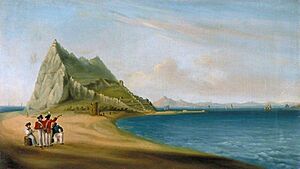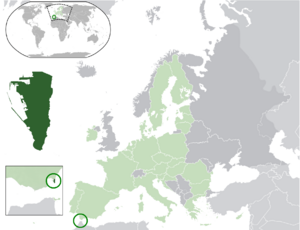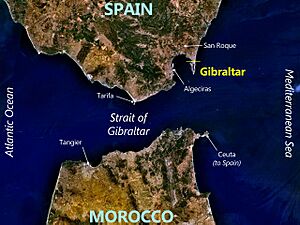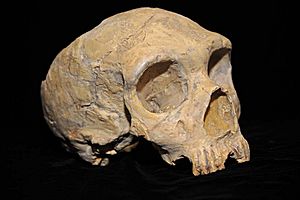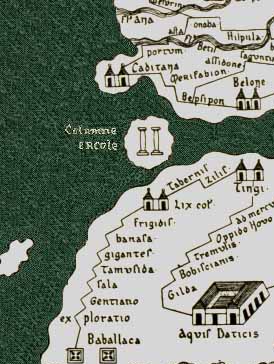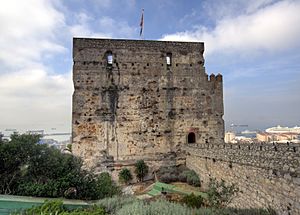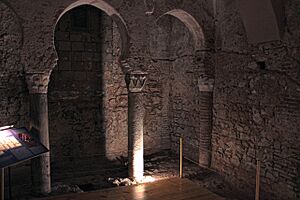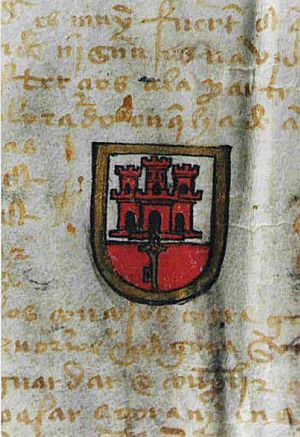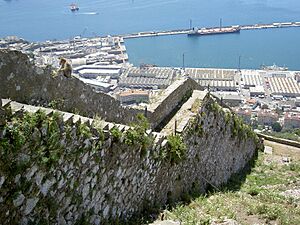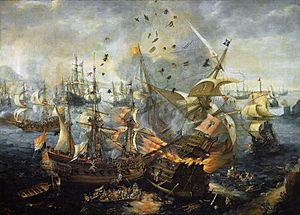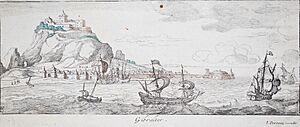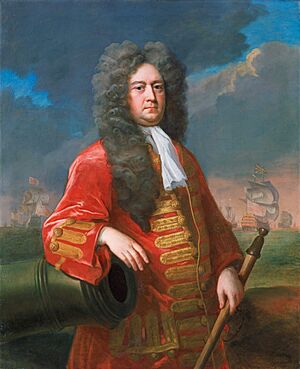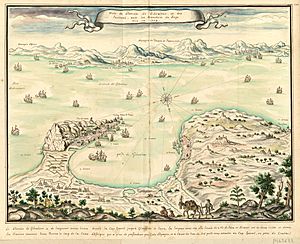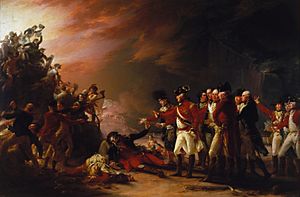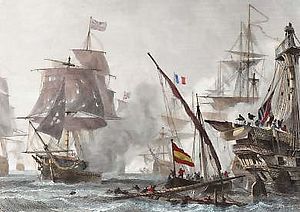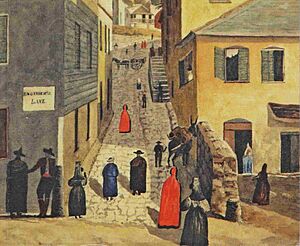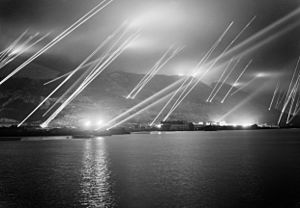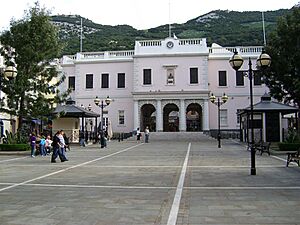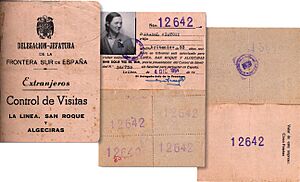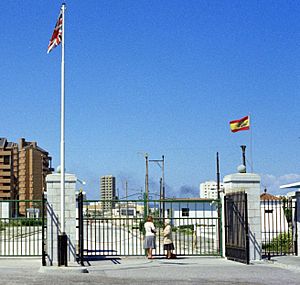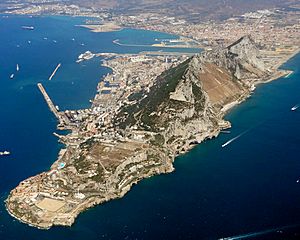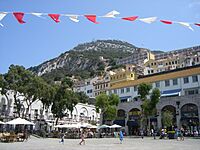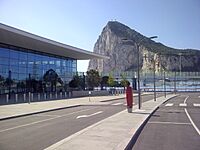History of Gibraltar facts for kids
The history of Gibraltar is a long story spanning over 2,900 years. Gibraltar is a small piece of land on the southern coast of Spain. It is located near the entrance to the Mediterranean Sea. This special location has made Gibraltar very important throughout history. It has been called "one of the most fortified and fought-over places in Europe." Its town, built in the Middle Ages, has seen many battles and sieges.
People first lived in Gibraltar over 50,000 years ago. These were Neanderthals. Evidence suggests Gibraltar might have been one of the last places they lived. Written history began around 950 BC with the Phoenicians. Later, ancient Greeks, Egyptians, Carthaginians, and Romans also visited. There is even proof of shrines built on the Rock of Gibraltar for the hero Hercules. The Romans called the Rock Mons Calpe, meaning "Hollow Mountain." They saw it as one of the two Pillars of Hercules.
Gibraltar became part of the Visigothic Kingdom after the Roman Empire fell. Then, in 711 AD, Muslim Moors took control. They settled Gibraltar permanently for the first time. They renamed it Jebel Tariq, which means "Mount of Tariq." This name later became "Gibraltar." The Christian Kingdom of Castile took it in 1309. They lost it to the Moors in 1333 but got it back in 1462. King Alfonso XI died from the Black Death in 1350 while trying to capture it. Gibraltar was part of Spain until 1704.
In 1704, an Anglo-Dutch fleet captured Gibraltar during the War of the Spanish Succession. At the end of the war, Spain gave Gibraltar to Britain in the Treaty of Utrecht in 1713. Spain has tried many times to get Gibraltar back. It was attacked and bombed during three wars between Britain and Spain. But each time, the attacks were stopped. By the late 1700s, Gibraltar had faced fourteen sieges in 500 years. After the Battle of Trafalgar, Gibraltar became a major military base. It grew quickly in the 1800s and early 1900s. It was a key stop for ships going to India through the Suez Canal. A large British naval base was built there. This base became very important for Gibraltar's economy.
During the Second World War, British control of Gibraltar helped the Allies control the Mediterranean entrance. German, Italian, and French forces attacked it, but without much success. After the war, Spanish dictator General Francisco Franco claimed Gibraltar again. Spain closed its border with Gibraltar from 1969 to 1985. Communication links were also cut. Latin American countries supported Spain. But Britain and the people of Gibraltar strongly said they wanted to remain British. Talks about Gibraltar's future continue between Britain and Spain.
Since 1985, Gibraltar has changed a lot. Most British forces have left. Gibraltar is no longer a major military base. Its economy now relies on tourism, money services, shipping, and online gambling. Gibraltar largely governs itself. It has its own parliament and government. The UK is still responsible for defense and foreign policy. Gibraltar's success has made it one of the wealthiest areas in Europe.
Contents
Gibraltar's Location and Importance
Gibraltar's history is shaped by its special location. It sits near the entrance of the Mediterranean Sea. It is a narrow piece of land on the eastern side of the Bay of Gibraltar. It is about 4 kilometers (2.5 miles) from the city of Algeciras. Gibraltar is on the very south coast of Spain. It is at one of the narrowest points in the Mediterranean. It is only about 24 kilometers (15 miles) from Morocco in North Africa. Its position on the bay makes it a great natural harbor for ships. As one writer said, "whoever controls Gibraltar also controls the movement of ships into and out of the Mediterranean." This makes it a very important military and naval spot.
The territory is only about 6.7 square kilometers (2.6 square miles) in size. Most of it is taken up by the steep Rock of Gibraltar. The Rock reaches a height of 426 meters (1,398 feet). The town of Gibraltar is at the base of the Rock on the west side. A narrow, flat strip of land connects Gibraltar to mainland Spain. The north side of the Rock is a nearly vertical cliff, 396 meters (1,299 feet) high. The only land access to the town is through a coastal strip. This strip was much narrower before land was reclaimed from the sea.
Gibraltar's geography gives it strong natural defenses. It is almost impossible to climb the eastern or northern sides of the Rock. They are either vertical or nearly so. To the south, the flat area around Europa Point is surrounded by cliffs up to 30 meters (98 feet) high. The western side is the only practical place to land. But even here, the steep slopes of the town help defenders. These features have made Gibraltar very important for military power over many centuries.
Ancient History of Gibraltar
Gibraltar looked very different in ancient times. Today, it is surrounded by sea. But long ago, the water level was much lower. The peninsula was surrounded by a rich coastal plain. This plain had marshes and sand dunes. Many animals and plants lived there.
Neanderthals lived in caves around the Rock of Gibraltar. In 1848, the first known adult Neanderthal skull was found at Forbes' Quarry. This was on the north side of the Rock. If people had known what it was then, the species might have been called "Gibraltarians." The skull is about 50,000 years old. More Neanderthal remains have been found in other caves on the Rock. Evidence from Gorham's Cave shows Neanderthals lived there as recently as 28,000–24,000 years ago. This was long after they were thought to have disappeared elsewhere in Europe.
After the Neanderthals, early humans (Homo sapiens) used Gibraltar's caves. Stone tools, old fireplaces, and animal bones have been found. These date from about 40,000 to 5,000 years ago. Pottery from the Neolithic period has also been found. There is little proof of people living there during the Bronze Age. By then, people had mostly stopped living in caves.
In ancient times, people from the Mediterranean saw Gibraltar as a special, religious place. The Phoenicians were there for several centuries. They used Gorham's Cave as a shrine. The Carthaginians and Romans did the same. People left pottery, jewelry, and Egyptian scarabs as offerings. They hoped for safe passage through the dangerous waters of the Strait of Gibraltar.
The Greeks and Romans respected the Rock as one of the two Pillars of Hercules. Hercules supposedly created them during his tenth labor. He broke through a mountain that separated the Atlantic and the Mediterranean. A Greek traveler from the 6th century BC said there were temples and altars to Hercules on the Rock. Travelers would make sacrifices there. Later, the Spanish used a symbol of two columns with a scroll. This symbol became the dollar sign ($).
The ancient Romans called Gibraltar Mons Calpe. This name might come from a Phoenician word meaning "hollowed out." This probably referred to the many limestone caves in the Rock. Ancient mapmakers knew about it. But there is no proof of permanent settlements from that time. Gibraltar had disadvantages for settlers. It lacked fresh water, good soil, or a safe natural harbor. Its location, which later became its strength, was not important then. The entrance to the Mediterranean was not fought over by the states of that time.
Because of this, ancient people settled at the head of the bay. This area is now called the Campo de Gibraltar. The town of Carteia was founded by the Phoenicians around 950 BC. The Carthaginians took control by 228 BC. The Romans captured it in 206 BC. Carteia was abandoned after the Vandals attacked it in 409 AD. The region then came under the rule of the Christian Visigoths.
Moorish Rule (711–1462)
By 681, the armies of the Umayyad Caliphate had spread from Arabia. They conquered North Africa, the Middle East, and parts of West Asia. They brought Islam and converted local people. The Berbers of North Africa, called Moors by Christians, became Muslims. The Strait of Gibraltar became the border between Muslim North Africa and Christian Spain. This made it very important. Spain fell into civil war in the 8th century. This gave the Moors a chance to invade Spain.
In April 711, a Berber army led by Tariq ibn Ziyad crossed from North Africa. They landed near Gibraltar. Tariq's expedition was a huge success. It led to the Islamic conquest of most of Spain. His conquest left a lasting mark on Gibraltar. Mons Calpe was renamed Jebel Tariq, or "Mount of Tariq." This name later became "Gibraltar."
Gibraltar was first fortified in 1160 by Sultan Abd al-Mu'min. He did this because of threats from Christian kings. Gibraltar was renamed Jebel al-Fath (Mount of Victory). A fortified town called Medinat al-Fath (City of Victory) was planned on the Rock. It's not clear how much of this town was actually built.
In the late 1200s and early 1300s, Christian Castile fought with the Marinids of Morocco and the Nasrids of Granada. They fought for control of the Strait of Gibraltar. This conflict was a big part of the Christian reconquest of Spain. A small fortified town likely existed in Gibraltar. It would have protected Algeciras and watched Christian fleets.
In 1309, Gibraltar's defenses were tested for the first time. King Ferdinand IV of Castile and James II of Aragon attacked the Muslim Emirate of Granada. In July 1309, the Castilians besieged both Algeciras and Gibraltar. Gibraltar had about 1,200 people, a castle, and basic defenses. These were not enough. Gibraltar's defenders surrendered after a month. Ferdinand kept Gibraltar. He expelled the Moors and brought in Christians. A keep and dockyard were built to secure Castile's hold. Ferdinand also gave special rights to encourage people to settle there.
In 1315, the Nasrid Moors of Granada tried to retake Gibraltar. But they stopped their siege when a Castilian relief force arrived. Eighteen years later, the Nasrid Sultan Muhammed and the Marinid Sultan Abu al-Hasan united. They besieged Gibraltar with a large army and navy. King Alfonso XI of Castile could not send help for months. The people of Gibraltar, starving, surrendered to the Moors. The Castilians then had to besiege the Moors. But they could not break through. Both sides agreed to a truce.
Abu al-Hasan strengthened Gibraltar's defenses. He built "strong walls as a halo surrounds a crescent moon." War broke out again in 1339. But his forces lost a big battle and fell back to Algeciras. The Castilians besieged Algeciras for two years and forced its surrender. But Gibraltar stayed in Moorish hands. Its defenses were much better now. Alfonso XI again besieged Gibraltar in 1349. But the Black Death arrived in 1350. It killed many of his soldiers and him.
Gibraltar remained Moorish until 1462. But it was fought over by the Nasrids and Marinids. In 1374, the Marinids gave it to the Nasrids. Gibraltar's soldiers rebelled in 1410. But a Granadan army retook it. Gibraltar was then used for raids into Christian land. This led to another siege in 1436, which failed badly.
Moorish rule ended in August 1462. A small Castilian force launched a surprise attack. Gibraltar's leaders and townspeople were away. After a short fight, the defenders surrendered. The Moorish people were again expelled. Christians replaced them.
Spanish Rule (1462–1704)
Soon after Gibraltar was retaken, King Henry IV of Castile made it Crown property. He brought back the special rights given earlier. Four years later, he was overthrown. His half-brother Alfonso became king. Alfonso gave Gibraltar to Medina Sidonia for his help. The governor, loyal to Henry IV, refused to give up Gibraltar. After a 15-month siege, Medina Sidonia took control. He died the next year. His son Enrique was confirmed as lord of Gibraltar. In 1474, the new Duke of Medina Sidonia sold Gibraltar to a group of Jewish converts. They were expelled two years later. His status was further improved by Isabella I of Castile in 1478.
On January 2, 1492, the Moorish rule in Spain ended. The Catholic Monarchs captured Granada. The Jews of Gibraltar, like others in Spain, were expelled that year. Gibraltar was used by Medina Sidonia to capture Melilla in North Africa in 1497. Two years later, Muslims in Granada were told to convert to Christianity or leave. Some left for North Africa through Gibraltar.
Gibraltar became Crown property again in 1501. The next year, it received new royal arms. Modern Gibraltar still uses them. Queen Isabella said Gibraltar was "the key between these our kingdoms in the Eastern and Western Seas." This meant the Mediterranean and Atlantic. The royal arms showed a golden key hanging from a fortress gate. The warrant said future Spanish monarchs must "hold and retain the said City for themselves."
At this time, "Gibraltar" meant the whole area, not just the peninsula. It included the land where towns like La Línea de la Concepción now stand. From the 16th century, the name "Gibraltar" came to mean only the town and the peninsula.
Under Spanish Crown rule, Gibraltar declined. The end of Muslim rule in Spain made its location less important. It had some small economic value from tuna fishing and wine. But its use as a fortress was limited. It became an ordinary stronghold. Marbella replaced it as the main Spanish port in the region.
Gibraltar's difficult land made it an unpopular place to live. To increase the population, convicts from Granada could serve their sentence in the Gibraltar army instead of prison. Despite this, Juan Alfonso de Guzmán, the third Duke of Medina Sidonia, tried to regain control. In September 1506, he besieged Gibraltar. He expected the gates to open quickly. But they did not. After a four-month blockade, he gave up. Gibraltar was given the title "Most Loyal" by the Spanish crown.
Pirate Raids and European Wars
Gibraltar was neglected by the Spanish crown. Its defenses fell apart. Barbary pirates from North Africa took advantage in September 1540. They raided Gibraltar. Hundreds of residents were taken hostage or enslaved. The Shrine of Our Lady of Europe was robbed. Many captives were later freed by a Spanish fleet. Spain then built the Charles V Wall to protect the south side of the Rock. They also hired an Italian engineer to strengthen other defenses.
The seas around Gibraltar remained dangerous. Pirate raids continued for decades. A small Spanish fleet tried to stop them, but it was not very effective. Many people were kidnapped and sold into slavery. The problem got worse after 1606. Spain expelled the Moriscos, Muslims who had converted to Christianity. Many joined pirate fleets.
Soon, Spain's enemies in northern Europe also became a threat. On May 5, 1607, during the Eighty Years' War, a Dutch fleet attacked a Spanish fleet in the Bay of Gibraltar. The Dutch won a huge victory. They lost no ships, while the entire Spanish fleet was destroyed. Spain and the Dutch made a truce in 1609. Hostilities started again in 1621. A Dutch and Danish fleet attacked Spanish ships. This time, the Spanish sank some of the attackers' ships.
An English military presence was briefly in Gibraltar in 1620. Spain let the English fleet use Gibraltar's port. This was for operations against Barbary pirates. Some in England wanted to attack Spain instead. But King James I resisted. The fleet returned to England. In 1625, a second English fleet was sent to attack a Spanish coastal town. Gibraltar was considered a target. It was small, easy to defend, and strategic. But the English attacked Cádiz instead. That raid failed.
The presence of enemies made King Philip IV of Spain strengthen Gibraltar's defenses. New gun platforms were built. The town was unhealthy and crowded. In 1649, an epidemic, possibly plague or typhoid, killed a quarter of the population. English fleets returned to Gibraltar in the 1650s. They were temporary allies of Spain against French and Dutch ships.
In 1654, Oliver Cromwell decided to attack Spain. He wanted to seize Hispaniola in the Caribbean. Two fleets were prepared. One went to America and took Jamaica. The other went to the Mediterranean. Cromwell became interested in capturing Gibraltar. He thought it would help trade and annoy the Spanish. In 1693, during the Nine Years' War, an English-Dutch fleet took refuge in Gibraltar. They were chased by the French. Eleven years later, Admiral George Rooke would return to capture it.
Capture by Britain (1704)
In November 1700, King Charles II of Spain died without children. A dispute over who should be king led to a major war in Europe. The war was called the War of the Spanish Succession. Philip of Anjou, grandson of the French King Louis XIV, was one choice. The other was Archduke Charles of Austria. Louis XIV supported Philip. England, the Netherlands, Austria, and others supported Charles. They feared French control of Europe. Philip became King Philip V of Spain and allied with France. In May 1702, England declared war on France.
Spain became a target for the alliance. Admiral Sir George Rooke led naval forces. In 1703, Rooke was told to attack French or Spanish coastal towns. He could choose the target.
Rooke considered several targets. An attempt to make Barcelona revolt failed. A plan to attack Toulon was abandoned. An earlier attempt to take Cádiz had also failed. Rooke decided to attack Gibraltar for three main reasons. It was poorly defended. It would be very important for the war. And its capture might make people in southern Spain turn against Philip.
The attack began on August 1, 1704. It was a joint operation. Naval forces were led by Rooke. Dutch and English marines were led by Prince George of Hesse-Darmstadt. After heavy bombing on August 2, the marines attacked the town. They advanced from the north and south. Gibraltar's defenders had food and ammunition. But they were greatly outnumbered. The Spanish position was hopeless. On the morning of August 4, the governor, Diego de Salinas, surrendered.
The surrender terms said Gibraltar was taken for Charles III of Spain. He was called the "legitimate Lord and King." The people and soldiers were promised religious freedom and rights if they stayed. But they had to swear loyalty to Charles. However, the attacking forces soon lost discipline. All but one Catholic church were damaged or turned into military stores. Religious symbols were destroyed. Angry Spanish people fought back.
When the Spanish soldiers left on August 7, almost all 4,000 people left the town. They refused to swear loyalty to Charles III. They stayed loyal to Philip V. They believed their exile would not last long. Fortresses often changed hands back then. Many settled nearby in the ruins of Algeciras. They hoped to return soon. They took the city council records, including Gibraltar's banner. Over time, the refugee settlement became the town of San Roque. A small group of about seventy people, mostly neutral Genoese, stayed in Gibraltar.
The Grand Alliance's control of Gibraltar was challenged on August 24. A French fleet entered the Straits. In the Battle of Vélez-Málaga, both sides lost many men but no ships. The French left without attacking Gibraltar. In early September, a Franco-Spanish army arrived outside Gibraltar. They began a siege on October 9. About 7,000 French and Spanish soldiers, helped by refugees, fought against 2,000 defenders. These defenders were English and Dutch marines and Spanish soldiers loyal to Charles.
British Admiral Sir John Leake helped the defenders from late October. More English and Dutch soldiers arrived by sea in December 1704. They brought fresh food and ammunition. Morale fell in the Franco-Spanish camp. Many soldiers left or got sick. King Louis XIV sent Marshal de Tessé to take command in February 1705. A Franco-Spanish attack was pushed back with heavy losses. On March 31, de Tessé gave up the siege.
During the war, British commandants governed Gibraltar. They were appointed by Charles III, then by Queen Anne. The Queen declared Gibraltar a free port. This was at the request of the Sultan of Morocco. The war ended in 1713 with the Treaty of Utrecht. Philip V was accepted as King of Spain. But France and Spain could not be unified. Spain gave up territories, including Gibraltar and Menorca, to Great Britain. The treaty said Gibraltar, its forts, and port were given to Britain "for ever." It also said if Britain ever gave up Gibraltar, it must first offer it to Spain.
British Rule (1713–Present)
Securing Gibraltar and Major Sieges
At first, Britain saw Gibraltar as something to trade, not a key asset. Its defenses were neglected. Keeping soldiers there was expensive. Spanish pressure threatened British trade. Seven times between 1713 and 1728, Britain offered to exchange Gibraltar for other things from Spain. But each time, the British Parliament stopped it due to public protests.
Spain and its people were unhappy about losing Gibraltar. In 1717 and 1718, Spanish forces retook Sardinia and Sicily. These had been given to Austria in the Treaty of Utrecht. Spain's actions led Britain to declare war. But Spain's gains were quickly reversed. Peace was restored in 1720.
In January 1727, Spain said the Treaty of Utrecht was no longer valid for Gibraltar. They claimed Britain had broken the terms. They said Britain extended forts, allowed Jews and Moors to live there, and harmed Spain's income by allowing smuggling. Spanish forces began a siege and bombing of Gibraltar the next month. It caused much damage. But the defenders held strong. They were reinforced by a British naval force. Bad weather and supply problems made the Spanish stop the siege in June.
Britain's control of Gibraltar was confirmed again in 1729 by the Treaty of Seville. Neither side was happy. Spain wanted Gibraltar back. Britain disliked the treaty's restrictions. Spain responded by building fortifications across the peninsula. This cut Gibraltar off from the mainland. These forts were called the Spanish Lines. They later gave their name to the town of La Línea de la Concepción. Gibraltar was blocked by land. But it could get food and supplies from Morocco.
Gibraltar's civilian population grew steadily. It became a mix of Britons, Genoese, Jews, Spaniards, and Portuguese. By 1754, there were 1,733 civilians, plus soldiers and their families. By 1777, the civilian population reached 3,201. This included Britons, Roman Catholics (Spanish, Portuguese, Genoese), and Jews. Each group had its own role. A Spanish historian in 1782 described them: "The richest mercantile houses are English... The Jews, for the most part, are shop keepers... The Genoese are traders, but most are fishermen and gardeners."
Life for soldiers was hard. Punishments were common. Soldiers often left because of boredom, food shortages, and poor living conditions.
Gibraltar's forts were updated in the 1770s. New batteries and walls were built. William Green, a skilled engineer, led this work. In 1776, George Augustus Elliott became governor. He was a veteran of earlier wars.
Britain's successes in the Seven Years' War led to new problems. The British government tried to tax its American colonies. This led to the American Revolutionary War in 1776. Spain declared war on Britain. Spain tried to get Gibraltar back with French help.
The Great Siege of Gibraltar lasted from June 24, 1779, to February 7, 1783. It was one of the longest sieges in history. A combined Spanish and French fleet blocked Gibraltar from the sea. On land, a huge army built forts and batteries to attack Gibraltar. Spain sent more and more troops and ships. The first help came in spring 1780. Admiral George Rodney defeated a Spanish fleet. He brought 1,052 men and many supplies.
The British defenders kept fighting. But supplies ran low again. On April 12, 1781, a British fleet arrived. It brought supplies, food, and ammunition. The Spanish fleet could not stop them. Frustrated, the Spanish bombed the town. This caused great fear among civilians. This targeting of civilians was new at the time. It continued for two years. It destroyed any old Spanish buildings. The French and Spanish tried more attacks. On November 27, 1781, the British soldiers made a surprise attack. They routed the enemy and delayed a big assault.
On September 13, 1782, the French and Spanish launched their "great attack." They used 10 new "floating batteries" with 138 heavy guns. Also, 18 warships, 40 Spanish gunboats, and 20 bomb-vessels. A total of 30,000 sailors and marines. They were supported by 86 land guns and 35,000 troops. The 138 guns fired from the floating batteries. The 86 land guns also fired. But the British fired "red-hot shot." This set fire to and sank the floating batteries and warships. The British destroyed three batteries. The other seven were sunk by the Spanish. 719 men on the ships were killed or wounded.
In Britain, plans were made for a major relief effort. In September 1782, a large fleet left under Richard Howe. It arrived off Cape St. Vincent on October 9. A gale scattered the Spanish and French fleet. Howe sailed into Gibraltar without opposition. He brought 34 warships and 31 supply ships. They delivered supplies, food, and ammunition. The fleet also brought more soldiers. Howe then fought a battle with the allied fleet before returning to Britain.
The siege continued for some months. But in spring 1783, a peace agreement ended the fighting. The siege was finally lifted in February 1783. The outcome of the Great Siege made it impossible for Britain to trade Gibraltar away. King George III worried it would cause "another war." But General Eliott and the soldiers were praised as heroes. Gibraltar's strength became famous. People still say something is "strong as the Rock of Gibraltar."
Gibraltar as a British Colony
After the Great Siege, Gibraltar's civilian population grew fast. It became a place for economic chances and a safe haven from the Napoleonic Wars. Britain lost its American colonies in 1776. So, much of its trade went to India and the East Indies. The best route was through Egypt, even before the Suez Canal. Gibraltar was the first British port ships reached. This new shipping traffic made Gibraltar an important trading port. Many new immigrants were Genoese people. They fled Napoleon's takeover of Genoa. By 1813, nearly a third of the population was Genoese and Italian. Portuguese, Spaniards, Jews, and Britons also lived there.
Gibraltar was an unhealthy place. It had poor sanitation. Epidemics of yellow fever and cholera often struck. They killed thousands of people and soldiers. An epidemic in 1804 killed over a third of everyone. Lord Nelson hoped Gibraltar would avoid the "dreadful scourge."
During the wars against Napoleon, Gibraltar was a Royal Navy base. It was used to block ports like Cádiz and Toulon. Then it became a gateway for British forces and supplies in the Peninsular War (1807-1814). In July 1801, French and Spanish naval forces fought two battles off Gibraltar. They ended badly for the Spanish. Two of their largest warships mistakenly attacked each other. They caught fire and exploded, killing nearly 2,000 sailors. Two years later, Gibraltar was a base for Lord Nelson. He tried to fight the French Admiral Villeneuve. This led to the Battle of Trafalgar. Nelson was killed, and Villeneuve was captured. Nelson's body returned to Gibraltar on HMS Victory. The Gibraltar Chronicle was the first newspaper in the world to report the victory at Trafalgar.
After Trafalgar, Gibraltar became a major supply base. It supported the Spanish uprising against Napoleon. The French invaded Spain in 1808. British soldiers from Gibraltar crossed the border. They destroyed Spanish forts around the bay. This stopped the French from besieging Gibraltar. French forces reached San Roque, north of Gibraltar. But they did not attack Gibraltar itself. They believed it was too strong. Gibraltar faced no military threat for a century.
After peace returned, Gibraltar changed a lot. General Sir George Don became governor in 1814. The damage from the Great Siege was repaired. But Gibraltar was still like a medieval town. Poor drainage caused epidemics. Don improved sanitation and drainage. He added street lighting. He rebuilt a hospital for civilians. He started building the Cathedral of the Holy Trinity for Protestants. For the first time, civilians had a say in running Gibraltar. An Exchange and Commercial Library was founded in 1817. It became a local civilian voice. A City Council was set up in 1821. In 1830, Gibraltar became a Crown colony. The Gibraltar Police Force was created. A Supreme Court was also set up.
Gibraltar's economy changed with steamships. The first one arrived in 1823. Steamships changed trade in the Mediterranean. Gibraltar's main business, transshipment, became less profitable. It was replaced by servicing steamships. This included coaling, supplying, and ferrying goods. Gibraltar became a key coaling station. British steamships refueled there on their way to Alexandria or Cape Horn. But the economic changes led to a long depression. It lasted until the late 1800s. The demand for coal workers led to many Spanish workers coming in. A shanty town grew up across the border. This became the town of La Línea de la Concepción. The poor economy meant Gibraltar's population barely changed. But it was still richer than southern Spain. So, La Línea's population doubled.
Relations with Spain were generally friendly in the 1800s. British officers and Gibraltar residents could cross into Spain. Some had second homes in San Roque. A major problem was smuggling. Spain taxed foreign goods and tobacco heavily. So, Gibraltar, with cheap goods, became a center for smuggling. This became a main part of Gibraltar's trade. An Irish traveler in the mid-1800s called Gibraltar "the grand smuggling depot for Spain." Governor Robert Gardiner described the daily scene. Spanish people would enter Gibraltar normally. But they would leave "swathed and swelled out with our cotton manufactures, and padded with tobacco."
The smuggling problem was reduced by adding duties on imported goods. This made them less attractive to smugglers. It also raised money for sanitation improvements. Despite earlier improvements, living conditions were still bad. A Colonel Sayer in the 1860s said the town was "small and crowded dwellings, ill ventilated, badly drained." Over 15,000 people lived in a small area. Sewers existed, but lack of water made them useless in summer. A Board of Sanitary Commissioners was set up in 1865. New drainage, sewerage, and water supply systems were built. This stopped major epidemics. Underground reservoirs were built inside the Rock. They could hold 22.7 million liters (5 million gallons) of water. Other services arrived: gas in 1857, telegraph by 1870, and electricity by 1897. Gibraltar also developed a good school system.
By the late 1800s, "Gibraltarians" got an official identity. By 1891, nearly 75% of the 19,011 people were born in Gibraltar. The growth of Gibraltarians as a distinct group was due to housing pressure. Gibraltar was still mainly a military fortress. Orders in Council in 1873 and 1885 said that only Gibraltar-born people had a right to live there. Everyone else needed permits. Besides Gibraltarians, there were also Britons, Maltese, and people from other British areas. There were also Spaniards, Portuguese, Italians, and Moroccans.
Gibraltar in Wars and Peace
By the late 1800s and early 1900s, Gibraltar's future as a British colony was uncertain. Its economic value was decreasing. New steamships could travel longer distances. They no longer needed to stop there for fuel. Its military value was also questioned. New long-range guns could reach Gibraltar from Spain. Torpedoes made ships in the bay vulnerable. The soldiers could hold out for a long time. But if an enemy held the Spanish coast, Gibraltar could not be resupplied.
Spain suggested swapping Gibraltar for Ceuta. This was considered but rejected. It was decided that Gibraltar's location as a naval base was too important. From 1889, the Royal Navy expanded. Gibraltar and Malta got new, torpedo-proof harbors and modern dockyards. The work at Gibraltar cost a huge amount of money. Gibraltar became the base for the Atlantic Fleet. In the public's mind, Gibraltar became a symbol of British naval power and empire.
The naval base's value was clear when the First World War began in August 1914. A German ship was captured by a torpedo boat from Gibraltar. Gibraltar was far from the main battlefields. Spain remained neutral. But Gibraltar played an important role against German U-boats. The naval base was heavily used by Allied warships for supplies and repairs. The Bay of Gibraltar was used as a meeting point for Allied convoys. German U-boats hunted targets in the Strait. Gibraltar's guns fired at U-boats twice, but missed. It was hard to stop U-boats. Just two days before the war ended, a German U-boat sank a British battleship near Gibraltar.
Peace meant less military spending. But this was balanced by more liner and cruise ship traffic. British ships going to India and South Africa stopped there. French, Italian, and Greek ships going to America also stopped. Oil bunkering became a major industry. An airfield was built in 1933. Civilian government was reformed. An Executive Council and elected City Council were set up in 1921. This was the first step towards self-government.
The Spanish Civil War began in July 1936. This caused security concerns for Gibraltar. The rebellion led by General Francisco Franco started across the Strait in Morocco. The Spanish Republican government tried to regain control of the Nationalist area around Algeciras. Gibraltar was not directly attacked. But the war caused problems. Many Spanish refugees, perhaps 10,000, fled to Gibraltar. This led to severe overcrowding. The Royal Navy operated from Gibraltar to stop foreign military aid to Spain. In May 1937, a British destroyer hit a mine. Eight crew members died. The Spanish Civil War deeply affected Gibraltar. British authorities and the wealthy supported the Nationalists. The working class supported the Republicans. As Europe moved towards war, Britain strengthened Gibraltar's defenses. A Gibraltar Defence Force was set up in March 1939.
Second World War
The Second World War began in September 1939. At first, it did not affect Gibraltar much. Spain and Italy were neutral. But the situation changed in April 1940. Germany invaded France, and Italy joined in June. Britain feared Spain would also join the war. So, the entire civilian population of Gibraltar was evacuated in May 1940. Most went to the United Kingdom. Others went to Madeira and Jamaica. Some went to Tangier and Spain.
An intense program of tunneling and refortification began. Over 30 miles (48 km) of tunnels were dug in the Rock. Anti-aircraft batteries were installed. A new naval group, Force H, was based at Gibraltar. It controlled the Mediterranean entrance. It supported Allied forces in North Africa and the Atlantic. The airfield was extended using soil from the tunnels. This allowed it to hold bomber aircraft. The number of soldiers grew. It reached 17,000 in 1943. Another 20,000 sailors and airmen were also in Gibraltar.
During the Battle of the Atlantic, Gibraltar was very important. Britain's convoy system used two routes. One was between the UK and North America. The other was between the UK, Gibraltar, and Freetown. Gibraltar was a main meeting point for convoys going to Europe. From late 1942, Gibraltar was the destination for convoys from the United States. These supported Allied operations in North Africa, Sicily, and Italy. Many Allied troops and ships used this route. Between November 1942 and August 1945, over 11,000 ships traveled between Gibraltar and the United States. Over 536,000 troops were transported from the United States to Gibraltar.
Gibraltar was attacked directly several times during the war. French aircraft bombed it in 1940. There were also raids from Italian and German aircraft. But they did not cause much damage. Franco's position changed from neutral to "non-belligerent." This meant he allowed Axis powers to operate secretly against Gibraltar from Spanish land. Franco chose not to join Hitler's plan to seize Gibraltar. A major reason was Spain's food supply. The country could not feed itself after the Civil War. It relied on grain imports from the Americas. These would have been cut off if Franco went to war with the Allies. Hitler eventually gave up the plan.
German and Italian spies watched Gibraltar constantly. They tried to carry out sabotage. Sometimes they succeeded. The Italians raided Gibraltar's harbor using human torpedoes and divers. They damaged merchant ships and sank one. Three Spanish spies working for Germany were caught in Gibraltar in 1942–43 and hanged. The threat to Gibraltar greatly reduced after Italy surrendered in September 1943.
Post-War Gibraltar and Modern Times
Gibraltar's civilians started returning in April 1944. But the last evacuees did not come home until February 1951. The immediate problem was a lack of ships. The longer-term problem was a lack of civilian housing. The soldiers were moved to the south of the peninsula to free up space. Military housing was used for returning civilians. A program to build new homes began. But progress was slow due to material shortages. By 1969, over 2,500 flats were built or being built.
After the war, Gibraltar took steps towards self-governance. The Association for the Advancement of Civil Rights (AACR) won all seats in the 1945 City Council elections. Women got the right to vote in 1947. A Legislative Council was set up in 1950. By 1955, a two-party system emerged. Joshua Hassan became the first Mayor of Gibraltar. The Governor still had overall power. But in 1964, Britain agreed to limit the Governor's powers. They would only cover defense, security, and foreign relations. A new constitution was made in 1968 and started in 1969. It combined the City Council and Legislative Council into a House of Assembly. The old title "Colony of Gibraltar" was dropped. The territory was renamed the City of Gibraltar.
Gibraltar's post-war relationship with Spain was difficult. The long-running dispute over its ownership grew stronger. Spain had not used military force since 1783. But the question of who owned it was still there. Disputes over smuggling and the sea border caused tensions. The neutral zone between Spain and Gibraltar also caused problems. This was a strip of sand about 1 kilometer (0.6 miles) wide. Over the years, Britain took control of most of it. Gibraltar's airport now occupies much of it. This expansion caused protests from Spain.
Spain's push to regain Gibraltar was helped by the United Nations' decolonization efforts. In 1946, Britain listed Gibraltar as a "Dependent Territory." But Gibraltar was unique. Because of the Treaty of Utrecht, it could only be British or Spanish. It could not become independent. Franco's government thought Britain would give up an expensive possession. But this was a mistake. The British government allowed colonies to become self-governing. Most chose independence. This was not an option for Gibraltar under the treaty. If Britain gave it up, it had to go back to Spain. The people of Gibraltar strongly opposed this. They held a referendum in September 1967. 12,138 voters chose to stay with Britain. Only 44 supported joining Spain. Spain rejected the results. They called the people "pseudo-Gibraltarians."
The dispute started with protests and diplomatic campaigns. From 1954, Spain put more and more limits on trade and movement across the border. More restrictions came in 1964. In 1966, the border was closed to vehicles. The next year, Spain closed its airspace to planes using Gibraltar's airport. In 1969, after Gibraltar's new Constitution, Spain closed the border completely. Gibraltar's phone links through Spain were cut.
This Spanish decision had big effects. Not just on relations between Spain and the UK. But also on the people of Gibraltar. Many had relatives or homes in Spain. One Gibraltarian described it: "The saddest sight was seeing people behind the wire fences... yelling... to enquire about the state of relatives." Phone calls were cut. People listened to Spanish radio for news of sick family members. In serious cases, people rushed to Spain via Tangier. But sometimes, the patient had already died. Spanish authorities would not allow access across the land border, even for emergencies.
Franco's death in 1975 led to diplomatic talks. Spain wanted to join the European Economic Community (EEC) and NATO. For this, it needed British support. In 1980, talks led to the Lisbon Agreement. This was about cooperation. It promised negotiations on Gibraltar's future. It also promised to lift Spanish restrictions. Britain promised to "honour the freely and democratically expressed wishes of the people of Gibraltar." Prime Minister Margaret Thatcher said sovereignty would be discussed. But the border did not reopen due to "technical issues." The agreement was opposed by many Gibraltarians. They did not want their sovereignty discussed. The Falklands War in 1982 caused more delays. Argentina tried to sink a British warship in Gibraltar's harbor. But Spanish police caught the saboteurs. Another agreement was reached in Brussels in 1984. It clarified the Lisbon Agreement. It said Britain must allow Spaniards to live and work in Gibraltar. The border finally fully reopened on February 4–5, 1985.
Modern Gibraltar
After the border reopened, Britain reduced its military presence. The naval dockyard closed. The RAF presence was also reduced. Military aircraft are no longer permanently stationed there. The British soldiers, present since 1704, left in 1990. This was due to defense cuts after the Cold War. Some military units remain under British Forces Gibraltar. Local soldiers now form the Royal Gibraltar Regiment. The Gibraltar Squadron oversees the security of Gibraltar's waters.
The military cuts greatly affected Gibraltar's economy. It had depended on defense spending. The government shifted its focus. It encouraged tourism and self-sufficiency. Tourism in Gibraltar was promoted. Key areas of the city were renovated. A new passenger terminal was built for cruise ships. New marinas and leisure facilities opened. By 2011, Gibraltar attracted over 10 million visitors a year. Its population was 29,752. This gives it one of the highest tourist-to-resident ratios in the world.
The government also encouraged new industries. These included financial services, duty-free shopping, casinos, and online gambling. Branches of major British stores opened. This encouraged visits from British people living on the nearby Costa del Sol. To help economic growth, a major land reclamation program was done. One-tenth of Gibraltar's land area was created from the sea. These efforts were very successful. By 2007, Chief Minister Peter Caruana said Gibraltar was "one of the most affluent communities in the entire world." As of 2013, Gibraltar was the second most prosperous territory in the European Union. It was 18th worldwide in terms of wealth per person. Today, Gibraltar has many accounting firms and banks per person.
- Key locations in modern Gibraltar
Gibraltar's relationship with Spain remains sensitive. By 2002, Britain and Spain suggested sharing control over Gibraltar. But Gibraltar's government opposed it. They held a referendum in November 2002. The agreement was rejected by 17,000 votes to 187. This was a 98.97% majority. Both governments said the result had no legal power. But the outcome stopped the talks. The British government accepted that an agreement without Gibraltar's support was unrealistic.
The 300th anniversary of Gibraltar's capture was celebrated in 2004. This drew criticism from some in Spain. In September 2006, talks between Spain, Gibraltar, and the UK led to a deal. This was called the Cordoba Agreement. It made it easier to cross the border. It also improved transport and communication links. Restrictions on Gibraltar's airport were lifted. This allowed airlines from Spain to land there. It also helped Spanish residents use the airport. The agreement did not address the issue of sovereignty. But this time, Gibraltar's government supported it. A new Constitution Order was approved in a referendum in November 2006.
See also
 In Spanish: Historia de Gibraltar para niños
In Spanish: Historia de Gibraltar para niños
- History of Spain
- History of the United Kingdom
- Political development in modern Gibraltar


